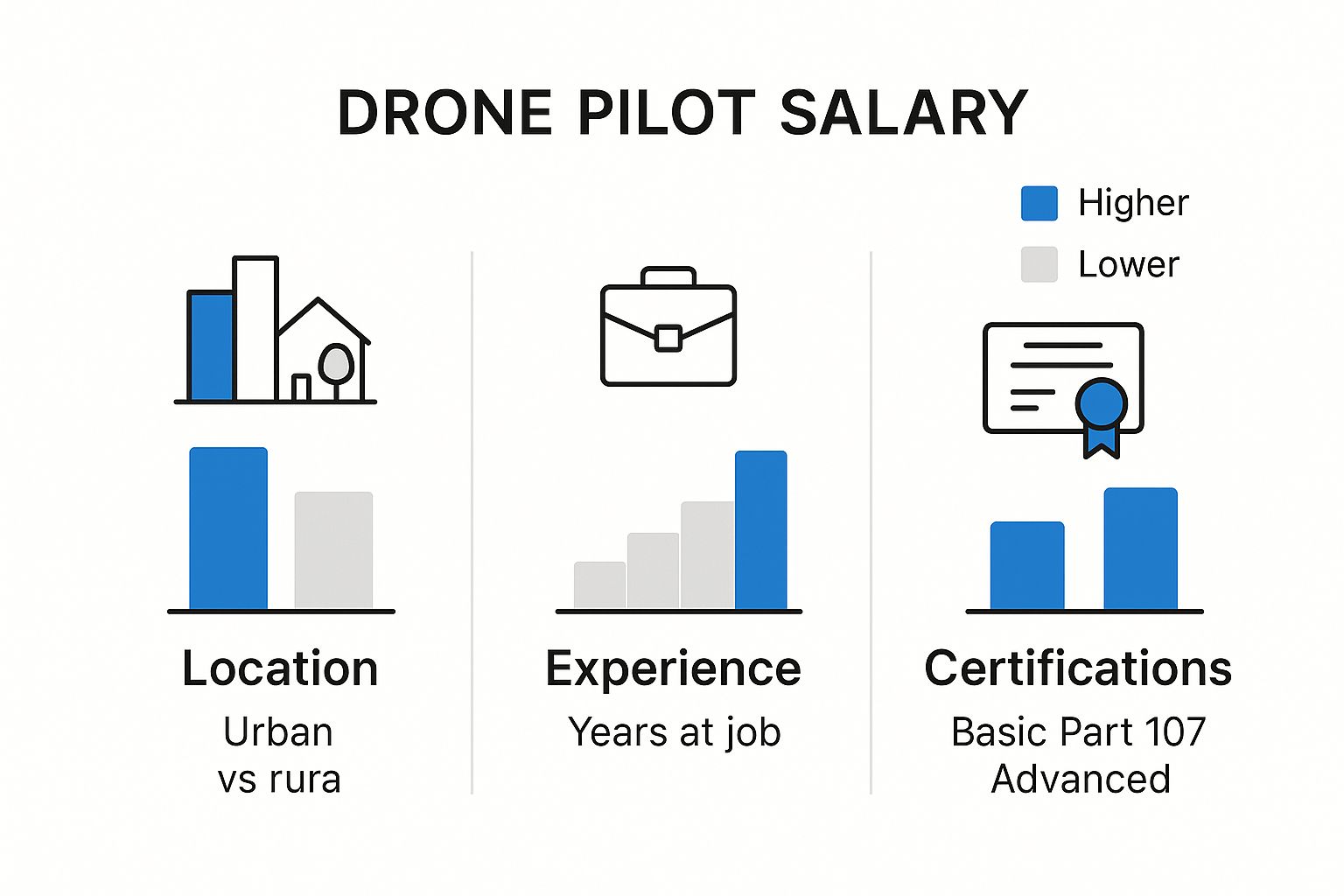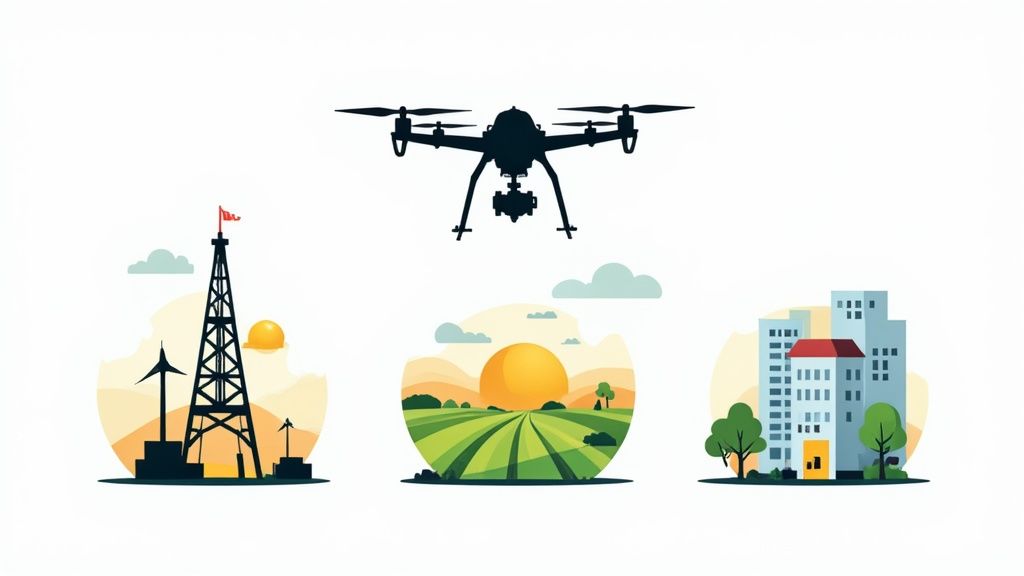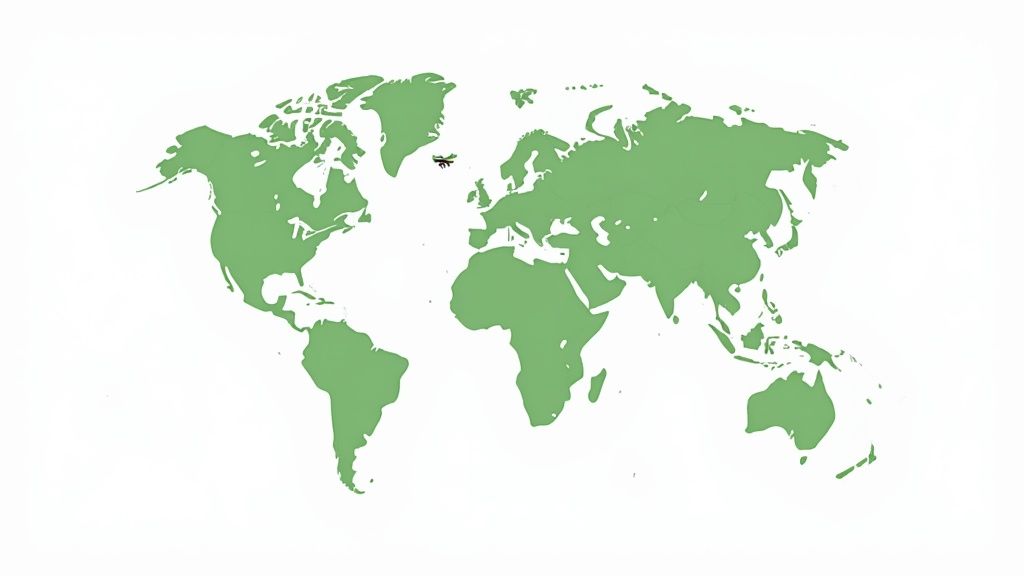Decoding the Commercial Drone Pilot Salary
- Paul Simmons

- Oct 9
- 13 min read
A commercial drone pilot's salary can swing wildly, starting around $42,000 for entry-level positions and soaring well over $100,000 for seasoned specialists. This massive range isn't a typo; it’s a direct reflection of the pilot's industry, experience, and the sheer complexity of the job at hand.
Unpacking the Drone Pilot Pay Scale

When you first start looking up what a drone pilot makes, you'll see numbers all over the place. That's because the "drone pilot" title is less of a specific job and more of a broad category, kind of like the word "driver." A taxi driver, a long-haul trucker, and a Formula 1 driver all operate vehicles, but their paychecks look drastically different.
It’s the exact same story in the drone world. The salary is directly tied to the value of the service being provided. A pilot snapping a few aerial photos for a local real estate agent is in a completely different ballpark than one conducting thermal inspections on multi-million dollar energy infrastructure. To get a better sense of where you might fit in, it's worth playing around with various salary benchmarking tools to see what the market looks like.
Salary Data from Industry Sources
Different platforms will show you just how wide this salary gap is. You might see one source reporting an average salary around $82,976, while another claims the average is closer to $130,986. The discrepancy usually boils down to who is included in the data set—they're often lumping entry-level freelancers in with highly specialized corporate operators.
The key takeaway is that your earning potential is not fixed. It’s a direct result of the skills you acquire, the experience you build, and the industry you choose to serve.
Ultimately, your career path and salary will be your own. By understanding the factors that influence pay, you can start making strategic moves to boost your earning potential right from the start.
Drone Pilot Salary Expectations by Experience Level
To give you a clearer picture, let's break down what you might expect to earn at different points in your career. The table below outlines some general salary ranges based on a pilot's experience level and the types of jobs they typically handle.
Experience Level | Typical Annual Salary Range | Common Job Types |
|---|---|---|
Entry-Level (0-2 years) | $42,000 - $65,000 | Real Estate Photography, Basic Event Videography, Construction Site Progression Photos |
Mid-Level (2-5 years) | $65,000 - $90,000 | Agricultural Surveying, Basic Infrastructure Inspection, Cinematography Support, Public Safety |
Advanced/Specialist (5+ years) | $90,000 - $130,000+ | Advanced Thermal/LiDAR Inspections, Feature Film Cinematography, Emergency Response Management |
Keep in mind these are just averages. A highly skilled specialist with a niche certification can easily push past these numbers, while a part-time freelancer might fall below the entry-level range. It all comes down to the value you bring to the table.
The Key Factors That Shape Your Drone Pilot Salary
Ever wonder why one Part 107 certified pilot is pulling in a six-figure income while another is just getting by? The national average salary is a decent starting point, but the reality is your actual paycheck gets hammered out by a handful of critical factors.
Think of it less as a single number and more as a range you can influence. It’s not just about logging more flight hours; it's about making smart moves that build your value in this fast-growing market.
Location, Experience, and Certifications Drive Earnings
The big three—where you live, how long you’ve been flying, and what you can do with the drone—are the most powerful forces shaping your income. A pilot based in a major hub like Los Angeles or New York City will find more high-ticket opportunities in industries like filmmaking or complex infrastructure inspections.
This often translates to an average salary that can be 10-20% higher than what you'd find in more rural areas.
This infographic gives you a quick visual breakdown of how these elements work together.

As you can see, stacking advanced specializations on top of your basic certification is where you’ll see the biggest jumps in what you can command.
Your Employment Status Matters
Another huge piece of the puzzle is whether you're working for a company or flying solo as a freelancer. Each path comes with its own financial pros and cons.
Full-Time Employee: This is the stability route. You get a steady paycheck, benefits like health insurance, and paid time off. The company also foots the bill for pricey equipment and insurance, but your earning potential might have a lower ceiling.
Freelance Operator: Going freelance means your income potential is, in theory, limitless. You call the shots on your rates, which can climb from $75 to over $200 per hour for highly specialized jobs. The trade-off? You're on the hook for every business expense, from marketing to insurance, and you have to navigate the slow periods between gigs.
For freelancers, figuring out how to set your rates is a make-or-break skill. Our guide on https://www.jabdrone.com/post/pricing-drone-services-tips-to-maximize-your-profits is a great place to start.
The choice between freelance and full-time work really boils down to your tolerance for risk versus your need for reward. Freelancing offers the higher hourly upside, while full-time employment provides that solid financial foundation.
Ultimately, your experience level is the great multiplier across all these factors. A brand-new pilot with under two years of experience might start out around $42,000. But a seasoned pro with more than five years and a portfolio of specialized flights can easily clear $90,000 or more.
And don't forget, no matter your path, [mastering salary negotiation techniques](https://www.jobcamp.ai/blog/2025/10/how-to-negotiate-salary/) is a vital skill for maximizing what you take home, especially when you're landing that next full-time role.
How Industry Specialization Impacts Your Earning Potential

Let's be clear: not all drone jobs are created equal. Where you decide to focus your skills will have a massive impact on your salary.
Think of your Part 107 license as a general driver's license. It gets you on the road, sure, but it doesn't automatically qualify you to drive a hazardous materials tanker or a massive piece of mining equipment. Those specialized roles demand extra training, involve more risk, and—you guessed it—pay a whole lot more.
The exact same principle applies in the world of commercial drones. While dipping your toes in with real estate photography is a common and accessible starting point, the paychecks in more technical, high-stakes industries are playing a completely different game.
A pilot inspecting a wind turbine or a cellular tower isn't just taking pictures. They're providing critical data that prevents catastrophic failures and keeps essential infrastructure online. The value they bring to the table is immense, and their pay reflects that reality.
High-Paying Drone Industries
Some sectors consistently pay top dollar because of the specialized skills, expensive gear, and heavy responsibility involved. In these fields, pilots are no longer just operators; they're vital technical specialists.
The top-tier industries for drone pilots almost always include:
Aerospace and Defense: This is the absolute pinnacle of drone pilot earnings. We're talking government contracts, high-level security clearances, and flying some of the most advanced UAVs on the planet. Salaries here can easily rocket past $200,000.
Energy and Utilities: Inspecting oil pipelines, power lines, and solar farms is dangerous work for a human crew, but it's a perfect job for a drone. This sector needs pilots with precision and deep technical know-how, pushing salaries frequently above $95,000.
Construction and Surveying: Using drones for site mapping, tracking progress, and building 3D models is now standard operating procedure. Skilled pilots in this space provide data that saves projects huge amounts of time and money, commanding an average of $95,966.
Comparing Common vs. Niche Sectors
On the flip side, more common fields like real estate photography or event videography are far more crowded. They can still be profitable, but the low barrier to entry means more competition, which naturally keeps a lid on salaries. A pilot in one of these fields might average closer to the $69,000 - $84,000 range.
To really see the difference, it helps to put the numbers side-by-side.
Commercial Drone Pilot Salary by Industry Sector
The table below breaks down the typical salary ranges and skills you'll need to succeed across the most popular drone industry sectors. It quickly becomes obvious where the real money is.
Industry Sector | Average Salary Range | Key Skills & Certifications Required |
|---|---|---|
Aerospace & Defense | $150,000 - $215,000+ | Security Clearances, Advanced UAS Experience, Data Analysis |
Energy & Utilities | $85,000 - $115,000+ | Thermal (Level I/II), LiDAR, Confined Space Training |
Mapping & Surveying | $75,000 - $100,000 | Photogrammetry Software (Pix4D, DroneDeploy), GIS Skills |
Real Estate | $55,000 - $85,000 | Advanced Photo/Video Editing, Bracketing (HDR) Skills |
Film & Video | $60,000 - $90,000 | Cinematography Skills, FPV Experience, Dual-Operator Proficiency |
The data tells a clear story: specializing in an industry that deals with high-value assets and has complex technical demands is the most direct path to a six-figure drone pilot salary.
Choosing your specialization is a major strategic career move. For a closer look at the specific roles that are paying the most, our article on the 7 lucrative jobs for drone operators in 2025 is a great resource to see where the biggest opportunities are hiding.
Ultimately, by matching your skills to the needs of a high-demand sector, you put yourself in the best possible position to maximize your earnings.
Beyond Borders: A Global Look at Drone Pilot Salaries

The buzz around skilled drone pilots isn't just a U.S. thing; it's a full-blown global phenomenon. But here’s the reality: what you can expect to earn depends heavily on where you are on the map. Your paycheck is a direct reflection of local laws, how mature the drone market is, and the general economic health of the country.
Think of it this way: in well-established markets like the United States, Canada, and parts of Europe, the salary range can be massive. An entry-level pilot in the U.S. might start around $35,000, while a seasoned pro in a highly technical role can pull in over $130,000. If you want to dive deeper into those numbers, you can find a ton of great info in this detailed salary guide.
North America: A Mature Market
North America, especially the U.S. and Canada, is home to one of the most developed commercial drone scenes out there. That maturity brings a mix of fierce competition and some seriously high-paying gigs, particularly in fields like defense, energy, and Hollywood filmmaking.
United States: As we've touched on, salaries here are all over the place, driven by your specialty and where you live. It's no surprise that states with big tech or film industries, like California and New York, tend to offer higher average pay.
Canada: Our neighbors to the north have a solid drone market, with big demand in natural resources, surveying, and agriculture. Pay is competitive, typically falling between CAD $50,000 to CAD $95,000, and even higher for pilots with deep experience.
If there's one key takeaway for pilots in North America, it's this: specialization is your golden ticket. Getting beyond basic aerial photos and into technical work like LiDAR mapping or thermal inspections is the fastest way to boost your earnings.
Europe: Navigating Diverse Regulations
Europe is a bit more of a patchwork quilt. The market can feel fragmented because of the different rules in each country, though the unified EASA (European Union Aviation Safety Agency) regulations are definitely helping to smooth things out.
Germany and the UK are often the leaders of the pack, thanks to strong industrial and media sectors that are hungry for skilled pilots. A typical salary in these areas can range from €40,000 to €70,000, but top specialists will command much more.
Australia and Oceania: The Resource-Driven Market
Australia's wide-open spaces and powerful mining and farming industries have created a unique—and profitable—niche for drone pilots. The work here is heavily focused on huge surveying projects, environmental monitoring, and managing massive agricultural operations.
Salaries down under are strong, usually landing somewhere between AUD $65,000 and AUD $110,000. The demand for pilots tough enough to operate in remote, challenging environments often means a premium paycheck, making it a fantastic region for anyone with a rugged skillset.
Certifications That Unlock Higher Paying Drone Jobs
Your FAA Part 107 certificate is the absolute first step—think of it as getting your driver's license. It proves you know the rules of the road, but it doesn't mean you're ready to operate a highly specialized, six-figure piece of machinery.
To really push your commercial drone pilot salary upward, you have to see the Part 107 as the foundation, not the ceiling. Advanced certifications are what separate the generalists from the specialists and open the door to the most lucrative jobs.
Think of it this way: anyone with a driver's license can deliver a pizza. But it takes special endorsements and serious training to haul hazardous materials or operate a massive crane. The pay difference is huge, and the same logic applies right here in the drone industry. Understanding why you need a 107 license is step one, but specializing is how you build a career.
Moving Beyond Basic Piloting
Advanced credentials transform you from a simple drone operator into a data acquisition expert. This is where the real value—and the bigger paycheck—is hiding. Employers aren't just paying for someone to fly a drone; they're paying a premium for pilots who can deliver actionable data.
Certain skills are in particularly high demand, and getting certified in them is a direct investment in your earning potential. These are the credentials that consistently lead to better-paying roles:
Level I Thermography: This certification teaches you how to properly use thermal cameras to see and interpret heat signatures. It’s a game-changer in the energy sector for inspecting solar panels, finding faults in power lines, and checking building insulation. A pilot with this skill is no longer just flying; they're a critical asset in preventative maintenance, and their salary shows it.
Photogrammetry & Mapping: Specializing in software like Pix4D or DroneDeploy allows you to create incredibly precise 2D maps and 3D models from drone imagery. Construction and surveying firms depend on this data for site planning and tracking progress, and they'll pay top dollar for pilots who can deliver accurate, survey-grade results.
LiDAR Operation: Light Detection and Ranging (LiDAR) is a high-end remote sensing method used to create astonishingly detailed topographical maps. It requires expensive equipment and specialized training, which puts pilots with LiDAR skills in a small, highly sought-after group, especially in forestry, archaeology, and advanced surveying.
Acquiring an advanced certification is the single most effective way to stand out in a crowded market. It tells employers you've moved beyond commodity services and can deliver specialized, high-value data they can actually use.
The Tangible Salary Impact
While the exact numbers can vary by region and industry, pilots with one or more of these advanced certifications can often command salaries 20-40% higher than those with only a Part 107.
For example, a pilot doing basic real estate photo shoots might earn around $55,000 a year. But a certified thermographer inspecting utility infrastructure can easily make $85,000 or more. Each certification you add is another powerful tool in your toolkit, turning you into an indispensable specialist rather than just another pilot for hire.
The Future of Drone Careers and Salary Growth
So, where is this all headed? It's the big question on every pilot's mind. Looking past today's job market, it's clear the very definition of a "professional drone pilot" is changing right before our eyes. The future isn't just about who has the best stick skills; it's about who can deliver the most valuable data.
As automation and artificial intelligence get smarter, the core of the pilot's role is shifting. Simple, repetitive flights—think flying the same grid over a field every week—will increasingly be handled by automated systems. This change is actually good news, pushing the commercial drone pilot salary up for those who are ready to adapt.
The spotlight is moving away from manual piloting and toward more complex, high-value work. Think less about the joystick and more about managing an entire fleet of autonomous drones, making sense of complex data streams, and plugging UAV operations into a company’s bigger picture.
The New Role of the Drone Professional
The pilot of tomorrow looks a lot more like a data specialist and a systems manager. The people who will truly succeed—and earn the big bucks—will be the ones who can act as a bridge between the drone in the sky and the business decisions on the ground. This evolution is carving out new career paths that simply didn't exist a handful of years ago.
The highest earners won't be just pilots; they will be drone program managers, data analysts, and robotics fleet coordinators. The value is shifting from the physical act of flying to the strategic interpretation of the data collected.
What this all means is that future-proofing your career is non-negotiable. Just having a Part 107 license isn't going to be enough to demand a top-tier salary for much longer. To really grow your income over the long haul, you’ll need to build a much more versatile skill set.
Skills That Will Drive Future Salaries
If you want to stay ahead of the curve and really maximize what you can earn, you need to focus on skills that work alongside automated flight, not compete with it. These are the areas where human expertise will stay essential and highly paid.
Data Analysis & Interpretation: Getting comfortable with photogrammetry, thermal imaging, and LiDAR software isn't just a "nice-to-have" anymore—it’s fast becoming a core job requirement. Companies are desperate for people who can turn that raw drone data into smart business decisions.
Fleet Management: As businesses start deploying dozens or even hundreds of drones, they'll need pros who can juggle maintenance schedules, keep the whole fleet compliant with regulations, and oversee large-scale automated missions.
AI and Machine Learning: Having a basic grasp of how AI algorithms process the imagery your drone captures will make you incredibly valuable. You become the human expert who can double-check the AI's findings and figure out what's wrong when sensor data gets complicated.
By digging into these areas, you position yourself as a key player in the industry's future. For a closer look at what’s on the horizon, check out our deep dive into the latest drone technology innovations and trends to watch. Taking this forward-looking approach is the best way to make sure your commercial drone pilot salary keeps climbing right alongside the technology itself.
Common Questions About Drone Pilot Salaries
Thinking about the money side of a new career path can be a little daunting. Let's clear the air and tackle some of the most frequent questions I hear from pilots who are just starting out.
Can I Really Make a Full-Time Living as a Freelancer?
You absolutely can, but it’s about more than just your skills at the controls. The most successful freelance pilots are also sharp entrepreneurs. They know how to market themselves, manage client relationships, and keep a close eye on their budget.
While freelance hourly rates look great on paper, often ranging from $75 to over $200, your annual income is a direct result of how well you can keep your project pipeline full. It’s a path that offers incredible freedom, but you trade the steady paycheck of a salaried role for that flexibility.
What Are the Real Startup Costs?
Getting your business off the ground will probably set you back between $1,500 and $5,000. That budget typically covers a solid professional drone to start, your Part 107 exam fee and study guides, and the all-important business liability insurance.
Just keep in mind, if you're aiming for specialized work like thermal inspections or high-end surveying, you'll need more advanced gear. That can push those initial costs up quite a bit higher.
How Quickly Can I Start Earning Money?
The good news is you can start earning almost as soon as you have your Part 107 certificate in hand. Smaller freelance gigs, like basic real estate photography, are a fantastic way to begin building your portfolio and getting paid right away.
That said, landing those bigger, higher-paying contracts usually takes a few months of solid networking and proving you're a reliable operator. It’s much healthier to think of your income growth as a steady climb, not an overnight jackpot.
At JAB Drone, we're here to give you the expert insights and reviews you need to make smart moves at every step of your career. Dive into our resources to stay ahead in the fast-moving world of drone technology. Learn more at JAB Drone.




Comments